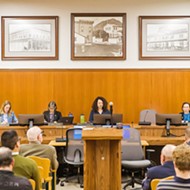Sentinel Peak Resources' new crude oil tanker truck proposal upsets SLO and Santa Barbara county residents
By Taylor O'connor[
{
"name": "Newsletter Promo",
"id": "NewsletterPromo",
"class": "inlineCenter",
"insertPoint": "4",
"component": "15264767",
"requiredCountToDisplay": "0"
},
{
"name": "Ad - Medium Rectangle CC01 - 300x250 - Inline Content",
"class": "inlineCenter",
"insertPoint": "8",
"component": "15582119",
"requiredCountToDisplay": "12"
},{
"name": "Ad - Medium Rectangle LC01 - 300x250 - Inline Content",
"class": "inlineCenter",
"insertPoint": "18",
"component": "15582122",
"requiredCountToDisplay": "22"
},{
"name": "Ad - Medium Rectangle 9 - 300x250 - Inline Content",
"class": "inlineCenter",
"insertPoint": "28",
"component": "15582121",
"requiredCountToDisplay": "32"
}]
Three days after Ken Hough told Santa Barbara County planning commissioners about "the dangers of crude oil tankers," a semi-truck carrying 150 barrels of crude oil crashed into another vehicle a half mile from his home.
The Santa Barbara County Action Network (SBCAN) co-executive director had filed an appeal on Santa Barbara County's approval of Sentinel Peak Resources' proposal to construct and operate a loading rack and truck oil from Lompoc through nearly 100 miles of San Luis Obispo County to Coalinga.
Though Santa Barbara County had placed mitigation measures on the project to improve trucking safety, SBCAN claimed the project needed an environmental impact report (EIR) due to its similarity to the controversial ExxonMobil trucking proposal, which the Santa Barbara County Board of Supervisors denied in 2022.
"Denials on ExxonMobil's proposal were based on the hazards of trucking oil on many miles of freeways and two-lane highways, and the same hazards are present here," Hough said during the Aug. 14 Santa Barbara County Planning Commission meeting. "SBCAN sincerely hopes you'll give direction today that will lead to denial."
Instead of upholding the appeal, the Planning Commission unanimously voted to direct staff to draft an adaptive management plan that would create an accountability system for Sentinel Peak if spills or accidents occur. The project and plan will come back before the commission on Oct. 30.
Santa Barbara County officials reached out to SLO County, Santa Maria, and Lompoc for input on the project but didn't get a response from any jurisdiction, said Errin Briggs, deputy director of the Santa Barbara County Planning Department's Energy, Minerals, and Compliance Division.
Sierra Club Santa Lucia Chapter Coordinator Gianna Patchen said she's worried about the impacts beyond Santa Barbara County.
More than 90 miles of the proposed route cut through SLO County, passing through a number of neighborhoods, particularly on Highway 46, that sit next to the highway with just grass between their property and the trucking route, Patchen said.
"Increased truck traffic does have an impact; six to 10 trucks a day, the round trip makes it 10 to 20 trucks a day," she said. "Truck crashes are not uncommon, spill incidents from these oil trucks are not uncommon. Any time that there's a project like this, it's important we take into consideration not only the impacts of spills on our ecosystems, but the truck emissions, [and] the safety for folks on the roads."
Patchen said that she'd like to see more effort on multi-jurisdictional engagement beyond one notification.
"A lot of stuff comes across their desk, and sending one notice and not hearing back is not a sufficient amount of effort to ensure they are aware this project is happening and their participation is part of the process," Patchen said. "In my opinion— of course, I'm not privy to all protocols behind the scenes, but you follow up a few times if something is going to be happening in their jurisdictions."
The Aug. 17 crude oil truck accident on E. Clark Avenue and Telephone Road in Santa Maria didn't spill any oil, but it did result in four injuries—reaffirming SBCAN's appeal and action in order to keep oil trucking operations out of Santa Barbara and SLO counties, Hough said.
Sentinel Peak Resources has operated in the Lompoc Oil Field since 2017, using the Phillips 66 pipeline 300 to transport crude to Coalinga until Phillips shut it down in 2023.
"Without this project, they're out of business. ... This is a lifeline for them," Briggs said.
The project would construct and operate a truck loading rack that would allow six to 10 crude oil tanker trucks to carry up to 160 barrels of crude oil for 165 miles one way, with a limit of 2,000 trips per year. The permit would last for 50 years or until a pipeline becomes available.
"We don't want to operate the truck rack for 50 years," said David Budy, Sentinel Peak's environmental health and safety manager. "There's discussions around bringing the pipeline back into service, and we're very interested in moving to that operation."
Tankers would travel Harris Grade Road from Lompoc, along Highway 1 to Highway 135 through Orcutt, Betteravia Road in Santa Maria, and then hit Highway 101 to cruise through SLO County. Truckers would connect to Highway 46 in Paso Robles, which turns into Highway 41, and then exit onto Highway 43 to head north to Coalinga.
While Sentinel Peak analyzed other routes, this path remained the most efficient and kept the project under California's greenhouse gas emissions threshold. Budy told commissioners that the company would be open to considering a 25-year permit and operating outside of peak commute times.
Although Sentinel Peak's proposal is similar to ExxonMobil's, Exxon's scale was much larger—proposing 70 truck trips a day during daylight hours, with six or seven trucks an hour, as opposed to Sentinel Peak's six to 10 truck round trips per day and only one truck per hour.
"Because of the circumstances of that project, when you look at ... environmental review, you look at the existing conditions and compare them to what the project was going to do," Briggs said. "Exxon had no operations, no pipeline—70-something trucks a day against nothing. With the current project, ... their baseline was the use of the pipeline. We weren't comparing trucking against nothing; we were comparing trucking against a pipeline."
If the proposal is approved, Sentinel Peak would generate a spill response protection plan that includes truck driver training and would stop operations during rainy days.
"Sentinel Peak has served as a diligent steward of the Lompoc field's energy resources during our operatorship, and this project—which does not include the drilling of any new wells—intends to continue that stewardship," Sentinel Peak Resources told New Times in an emailed statement. "The Lompoc field has contributed energy resources to the state since 1903, and Sentinel Peak's project serves those needs under a highly regulated environment while also supplying much-needed jobs to California residents."
Santa Barbara County Planning Commissioner John Parke expressed concern about other Central Coast cities not being in the loop.
"One thing that disturbs me is we aren't sure whether we've afforded an opportunity for other jurisdictions, counties, cities that are affected by this," Parke said. "Another concern is the duration of this project. ... I think 50 years is too darn long."
Parke, whose district encompasses the construction portion of the project, suggested the adaptive management plan because it enables projects permitted for long periods of time to move forward, but it allows "another look" if something happens, rather than going to an EIR.
"If we had an EIR, it would take some time and quite a bit of expense and raise this issue again," Parke told New Times. "We're not exactly back to square one, but maybe this would be a way to ... give neighborhoods some practical protections."
Parke has supported and suggested adaptive management plans for other projects, including cannabis permits to regulate odor control, the Channel Islands YMCA to ensure security for 24/7 operations, and the Strauss Wind Energy windmill project near Lompoc to prevent bird deaths.
Sentinel Peak's adaptive management plan is in its early stages of development, but Briggs imagined it would have a tiered system, with accidents or spills triggering the response.
"It seems like a good idea in certain situations, and I would agree it's been helpful to Strauss [Wind Energy]," Briggs said, "and I could see some benefit to having it on the trucking project." Δ
Reach Sun Staff Writer Taylor O'Connor, from New Times' sister paper, at [email protected].
Latest in News
Readers also liked…
-

When the levee breaks: Oceano residents, county officials walk a tightrope of regulations to manage Arroyo Grande Creek, which some say led to the levee's failure in January
May 18, 2023 -

Cal Poly report highlights offshore wind's potential to spur green energy transition
Jun 8, 2023 -

Cal Poly students demand rent control, accountability for substandard housing from SLO City Council
Jun 22, 2023








